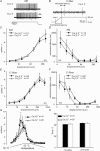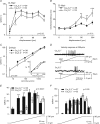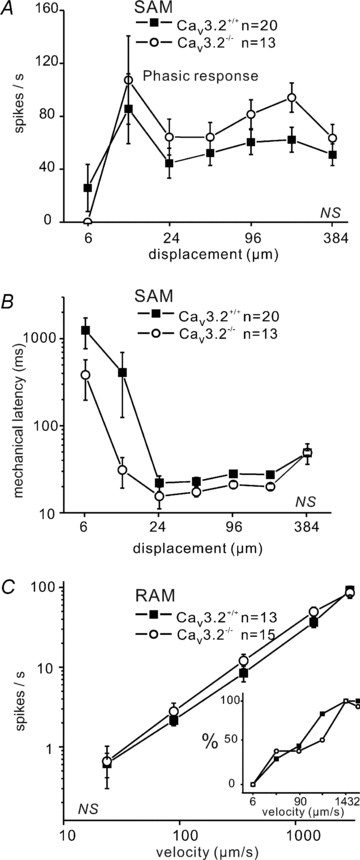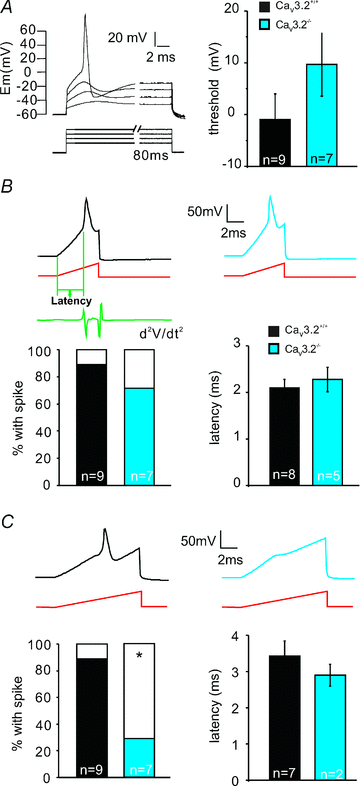The Cav3.2 T-type calcium channel regulates temporal coding in mouse mechanoreceptors
- PMID: 21486775
- PMCID: PMC3098700
- DOI: 10.1113/jphysiol.2010.203463
The Cav3.2 T-type calcium channel regulates temporal coding in mouse mechanoreceptors
Abstract
In mammals there are three types of low-voltage-activated (LVA) calcium channels,Cav3.1, Cav3.2 and Cav3.3, which all give rise to T-type Ca2+currents. T-type Ca2+currents have long been known to be highly enriched in a sub-population of medium-sized sensory neurones in the dorsal root ganglia (DRG). However, the identity of the T-type-rich sensory neurones has remained controversial and the precise physiological role of the Cav3.2 calcium channel in these sensory neurones has not been directly addressed. Here we show, using Cav3.2−/− mutant mice,that these channels are essential for the normal temporal coding of moving stimuli by specialized skin mechanoreceptors called D-hair receptors.We show that D-hair receptors from Cav3.2−/− fire approximately 50% fewer spikes in response to ramp-and-hold displacement stimuli compared to wild type receptors. The reduced sensitivity of D-hair receptors in Cav3.2−/− mice is chiefly due to an increase in the mechanical threshold and a substantial temporal delay in the onset of high-frequency firing to moving stimuli.We examined the receptive properties of other cutaneous mechano receptors and Aδ- and C-fibre nociceptors in Cav3.2−/− mice, but found no alteration in their mechanosensitivity compared to Cav3.2+/+mice. However, C-fibre nociceptors recorded in Cav3.2−/− mutant mice displayed a small but statistically significant reduction in their spiking rate during noxious heat ramps when compared to C-fibres in control mice. The T-type calcium channel Cav3.2 is thus not only a highly specific marker of D-hair receptors but is also required to maintain their high sensitivity and above all to ensure ultra rapid temporal detection of skin movement.
Figures






Comment in
-
Mice mechanoreceptors are modulated by Ca(v)3.2 T-type calcium channels.J Physiol. 2012 Jan 1;590(1):7. doi: 10.1113/jphysiol.2011.221507. J Physiol. 2012. PMID: 22210285 Free PMC article. No abstract available.
Similar articles
-
Pharmacological dissection and distribution of NaN/Nav1.9, T-type Ca2+ currents, and mechanically activated cation currents in different populations of DRG neurons.J Gen Physiol. 2007 Jan;129(1):57-77. doi: 10.1085/jgp.200609665. J Gen Physiol. 2007. PMID: 17190903 Free PMC article.
-
Immunohistological demonstration of CaV3.2 T-type voltage-gated calcium channel expression in soma of dorsal root ganglion neurons and peripheral axons of rat and mouse.Neuroscience. 2013 Oct 10;250:263-74. doi: 10.1016/j.neuroscience.2013.07.005. Epub 2013 Jul 15. Neuroscience. 2013. PMID: 23867767 Free PMC article.
-
Piezo2 voltage-block regulates mechanical pain sensitivity.Brain. 2024 Oct 3;147(10):3487-3500. doi: 10.1093/brain/awae227. Brain. 2024. PMID: 38984717 Free PMC article.
-
Functional importance of T-type voltage-gated calcium channels in the cardiovascular and renal system: news from the world of knockout mice.Am J Physiol Regul Integr Comp Physiol. 2015 Feb 15;308(4):R227-37. doi: 10.1152/ajpregu.00276.2014. Epub 2014 Dec 17. Am J Physiol Regul Integr Comp Physiol. 2015. PMID: 25519728 Review.
-
Aδ-fiber low threshold mechanoreceptors innervating mammalian hairy skin: A review of their receptive, electrophysiological and cytochemical properties in relation to Aδ-fiber high threshold mechanoreceptors.Neurosci Biobehav Rev. 2016 Feb;61:225-38. doi: 10.1016/j.neubiorev.2015.12.009. Epub 2015 Dec 30. Neurosci Biobehav Rev. 2016. PMID: 26746589 Review.
Cited by
-
The mechanosensory neurons of touch and their mechanisms of activation.Nat Rev Neurosci. 2021 Sep;22(9):521-537. doi: 10.1038/s41583-021-00489-x. Epub 2021 Jul 26. Nat Rev Neurosci. 2021. PMID: 34312536 Free PMC article. Review.
-
Stomatin-domain protein interactions with acid-sensing ion channels modulate nociceptor mechanosensitivity.J Physiol. 2013 Nov 15;591(22):5555-74. doi: 10.1113/jphysiol.2013.261180. Epub 2013 Aug 19. J Physiol. 2013. PMID: 23959680 Free PMC article.
-
Expression and Regulation of Cav3.2 T-Type Calcium Channels during Inflammatory Hyperalgesia in Mouse Dorsal Root Ganglion Neurons.PLoS One. 2015 May 14;10(5):e0127572. doi: 10.1371/journal.pone.0127572. eCollection 2015. PLoS One. 2015. PMID: 25974104 Free PMC article.
-
Transduction and encoding sensory information by skin mechanoreceptors.Pflugers Arch. 2015 Jan;467(1):109-19. doi: 10.1007/s00424-014-1651-7. Epub 2014 Nov 23. Pflugers Arch. 2015. PMID: 25416542 Review.
-
Lack of evidence for participation of TMEM150C in sensory mechanotransduction.J Gen Physiol. 2022 Dec 5;154(12):e202213098. doi: 10.1085/jgp.202213098. Epub 2022 Oct 18. J Gen Physiol. 2022. PMID: 36256908 Free PMC article.
References
-
- Airaksinen MS, Koltzenburg M, Lewin GR, Masu Y, Helbig C, Wolf E, Brem G, et al. Specific subtypes of cutaneous mechanoreceptors require neurotrophin-3 following peripheral target innervation. Neuron. 1996;16:287–295. - PubMed
-
- Aptel H, Hilaire C, Pieraut S, Boukhaddaoui H, Mallie S, Valmier J, Scamps F. The Cav3.2/α1H T-type Ca2+ current is a molecular determinant of excitatory effects of GABA in adult sensory neurons. Mol Cell Neurosci. 2007;36:293–303. - PubMed
-
- Barton ME, Eberle EL, Shannon HE. The antihyperalgesic effects of the T-type calcium channel blockers ethosuximide, trimethadione, and mibefradil. Eur J Pharmacol. 2005;521:79–85. - PubMed
-
- Bilici D, Akpinar E, Gursan N, Dengiz GO, Bilici S, Altas S. Protective effect of T-type calcium channel blocker in histamine-induced paw inflammation in rat. Pharmacol Res. 2001;44:527–531. - PubMed
Publication types
MeSH terms
Substances
LinkOut - more resources
Full Text Sources
Other Literature Sources
Molecular Biology Databases
Miscellaneous

